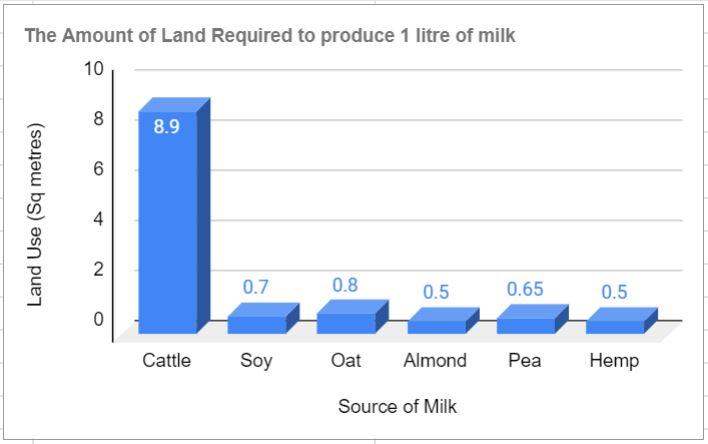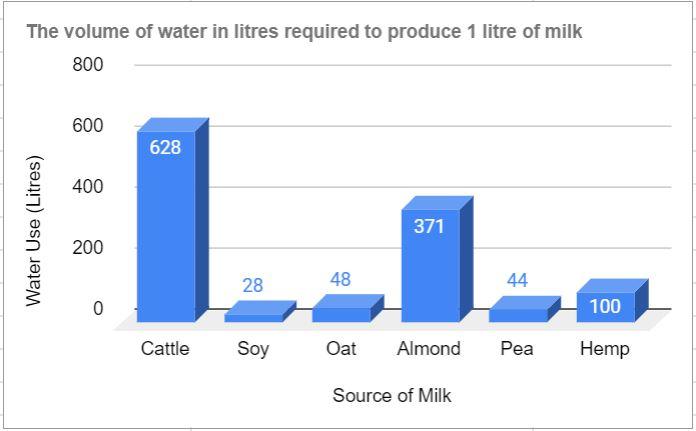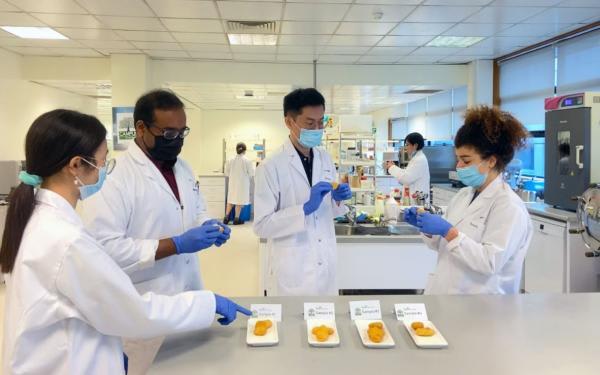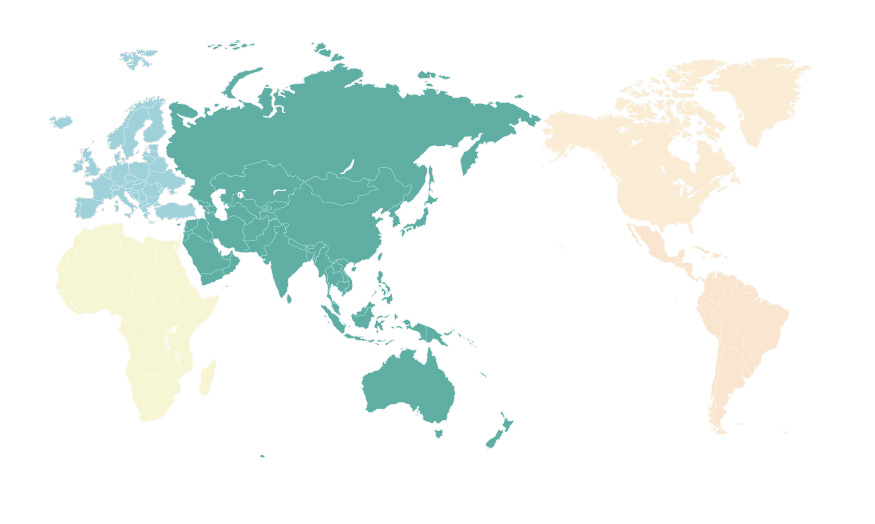Main Theme

Subtema: Producto alternativo; Agricultura
Abstract
The total emission from livestock is 7.1 Gigatonnes of CO2-equivalent, which represents 14.5% of the global GHG emissions. 65% of the global GHG emission is attributed to the cattle population – – 45% of the world’s cattle can be found in 6 Asia-Pacific countries: India, China, Australia, New Zealand, Japan, and South Korea. 20% of the sector’s GHG output is attributed to the production of milk and milk-based products. In addition to GHG emission, milk from cattle also places a burden on the water and land resources of a country. There is also the fact that health restrictions and dietary choices are making alternatives to cattle milk a necessity for significant parts of society.
There is thus a need to compensate for the growth in consumption through alternate sources of milk. One option is plant-based milk which is comparatively more sustainable than cattle milk and performs better on key indicators such as land use, water requirements, GHG emission, and fossil fuel usage.
Singapore is emerging as the hub for plant-based alternate sources of milk with a wide variety of sources such as peas, almond, oats, soy, etc. Foreign organizations such as Firmenich, ADM, and Oatly have invested heavily to capitalize on the growing plant-based alternative milk market, while more regional and local organizations such as Only Earth and Yeo’s are also in the mix to expand within Singapore and throughout the Asia-Pacific region to make alternative sustainable options for milk.
Sustainable Development Goals Chart

Main Highlights
Milk Production: Excess Strain on Resources
- It requires approximately 1.345 kg of feed to make 1 litre of milk.
- 1 litre of milk produces 3.31 kg CO2e of emission.
The Need for Different Sources of Milk
- With the amount of land available to make 1 litre of milk (8.9 square metres), 11.125 litres of oat milk, 12.714 litres of soy milk, and 17.8 litres of almond milk can be produced.
- The amount of water required to produce 1 litre almond, hemp, oat, pea, and soy milk is 50%, 16%, 7.6%, 4.45%, 4% of the amount of water required to produce 1 litre of cattle milk respectively.
Singapore: The Hub for Alternate Milk
- 90% of the population is aware of the need for plant-based alternatives to compensate for climate change.
- High lactose intolerance of 90% in the region positions the country prime for experimentation with milk alternates.
- Favourable policies from the government and strong local initiatives positions Singapore as a strong candidate for foreign investment.
Impact Statement
- Plant-based milk alternatives produce 1/3rd of the GHG emissions when compared with Cattle Milk.
- As sustainable as plant-based milk alternatives are in comparison to cattle milk, Government bodies will have to take large scale unemployment and policy development into consideration before shifting to plant-based milk alternatives.
Systems Perspective
- Singapore has been able to forge ahead as the hub for plant-based milk alternatives due to favorable government policies, need for dietary choices, awareness around climate change, and a lack of large population involved in dairy farming.
- Choosing the right plant for an alternate source of milk is dependent on nutrition level, water use, and land use.
Case Overview
Milk Production: Excess Strain on Resources
The Asia-Oceanic region accounts for 34% of the global milk production. This rate of production results in the emission of 407.69 million CO2e annually from the Asia-Oceanic region alone. The production of milk from cattle also places a stress on the environment through the use of animal feed, fossil fuel in the supply chain, and strain on water resources.
70% of the total cost of livestock management is accounted for by animal feed. The need for animal feed results in the development of factory farms, which comes at the cost of forest land. There is already a growing livestock feed deficit. In the Asia-Oceania region alone, it is estimated that around 450 million cattle are present, leading to the need for 41.24 million tonnes of feed per year. There is also a growing need for more fodder to keep up with the milk production with many countries such as India, China, South Korea, and Australia facing feed shortage leading to the over utilization of land resources.

Image 1: Per-capita land by major land cover types for 2000/2050 populations (Indication of growing land scarcity) | Source: The Poultry Site
The Need for Different Sources of Milk
There are several alternatives to cattle milk with Singapore and Malaysia emerging as the global hub for alternate milk. The need for alternate sources of milk not only stems from the need for efficient use of resources but also due to the region having a population that is aware of climate change and lactose intolerance. It is estimated that 9 in 10 people in Singapore are aware of the need for change to combat climate change and more than 90% of the population suffers from some degree of lactose intolerance.
The primary alternate sources being almond, oat, pea, hemp, and soy. The alternate sources will be analyzed to determine effectiveness in terms of land use, water requirements, and GHG emissions.

Image 2: The Amount of Land Required to produce 1 litre of milk from different sources
Cattle milk generally requires approximately 9 times more land than plant-based alternatives. With 1 litre of milk requiring 8.9 square metres of land per year. In comparison 1 litre of oat, soy, and almond milks require 0.8, 0.7, 0.5 square metres of land per year. Pea and hemp are newer entrants in the field of alternate milk and are comparable to soy and almond respectively in terms of land use.

Image 3: The volume of water required to produce 1 litre of milk from different sources
The other major problem in the production of cattle milk is the use of water. Currently, 1 litre of cattle milk requires 628 litres of water. For the production of 1 litre of oat, pea, and soy milk, the volume of water required is only 48, 44, and 28 litres respectively. Hemp and almond are on the higher end of the spectrum with 100 and 371 litres of water needed for 1 litre of milk production respectively.
In terms of fossil fuel utilization,research is in its nascent stages. However, initial research has shown that 0.385 litres of diesel fuel can be used to produce 1 litre of soy milk, when compared to the 17.318 litres of diesel fuel required in the production of 1 litre of cattle milk. It is estimated that the amount of GHG emission from almond, soy, pea, oat, and hemp milk are considerably lower than cattle milk with oat milk particularly standing out with 80 percent lower GHG emissions and 60 percent less energy use compared to cow’s milk.
Singapore: The Hub for Alternate Milk
The growth of plant-based milk alternatives has not suddenly grown in popularity in Singapore. It has been predicted since late 2018 by the F&B sector that has embraced the concept of dairy-free milk products. The growth of Singapore as a hub for alternate milk is due to a blend of scalable innovation, consumer demand, and governmental support. Most notably, the demand from consumers is due to 9 in 10 Singaporeans being concerned about climate change and therefore looking to take up a plant-based diet to offset the problem. This thought process has enabled the industry to rapidly grow.
It has also enabled collaborative partnerships between public and private sector organizations in Singapore and large multinational corporations looking to explore the plant-based alternate milk sector. This can be seen with Firmenich and the Singapore Economic Development Board (EDB) collaboratively launching SmartProteins in 2021. Chicago-based ADM has also invested in the development of an innovation hub in Singapore to enable research and development in the field of plant-based alternatives. Swedish food company Oatly has invested $22 million USD to establish a production facility along with Yeo’s, a Singaporean beverage company.

Image 4: Firmenich SmartProteins® Innovation Hub | Source: Firmenich
The country also has significant companies within the plant-based alternative milk space with Only Earth establishing itself as a major player in the market. The company has also expanded into India, where the alternate milk market is said to grow to $64 million by 2024. Only Earth already has the supply chain developed and is looking to establish itself in other key markets in the Asian region.
Impact Statement
We have to highlight that plant-based milk alternatives are being driven in Singapore, which unlike other Asian and Oceania countries, does not have a significant cattle population nor does it have a significant workforce that is associated with dairy farming. This makes the opportunity for sustainable milk alternatives to be developed more likely in the country as compared to other places.
However, plant-based milk alternatives has a role to play in other geographies as well as a sustainable alternative to cattle milk, making the potential for adoption to other countries, as in the case of Only Earth into India, more likely in the coming years:
- Cattle-based methane emissions are the largest source of GHG emissions in agriculture, accounting for 62% of the sector’s emissions – livestocks contribute to 14.5% of global GHG emissions. It is a highly resource intensive process, with GHG emissions more than 3 times more intensive, while water and land use significantly higher and extensive, which creates wider societal issues as issues around deforestation and water scarcity become more prevalent.
This does show a need to change how we produce milk, and deriving milk from non-cattle sources, is one of the most forward, and innovative ways we have, by being more land and water efficient as compared to cattle milk – land required for plant-based alternatives is up to 9 times less than that for cattle milk; while water-usage is anywhere between 2 to 12 times less-intensive based on the type of plant that is being used:
- soy-based milk: 28 litres of water for 1 litre of milk
- oat: 48 litres;
- pea: 44 litres;
- hemp milk: 100 litres; and
- almond milk around 371 litres
The adoption of plant-based milk in areas outside of Singapore, where the impact would be arguably larger, are likely to be impacted more due to nutrition and societal causes.
- The milk and dairy sector is a significant job creator. Demand for dairy can lead to a larger number of rural dairy farmers across the Asian region without a source of income leading to wider societal and economic issues, for example, India has over 150 million dairy farmers.
- Cattle milk is a source for calcium, iodine, protein, and vitamin D. For example, 38% of iodine intake in adults is attributed to milk and milk-based products. The shift to plant-based alternative milks does provide consumers with a protein rich supplement, however, there would be an increased need to substantiate iodine and calcium intake through other means.
Systems Perspective
The Verdict
Most of the different sources of alternate milk are comparable to each other in terms of land use, water use, and GHG emissions. Plant-based sources of milk are more sustainable than cattle milk, but adoption of the same has several barriers. The utilization of dairy-milk is intertwined with rural employment in some countries and there is also a lack of awareness around climate change and lactose intolerance. The latter in particular is one of the major reasons for Singapore emerging as the hub for alternate sources of milk because there is a demand in the market for the same. The demand prompts government agencies to prompt action at the policy level and foreign organizations to invest at the R&D level.
Choosing the Right Source

Image 5 : Comparison of different types of milk on nutrition level, land use, and water use
Nutrition
From a consumption perspective, soy and pea are known to be the most nutritious due to their high protein content. Among the five plant-based milk alternatives, hemp comes in third in terms of nutrition content fairing just below the legume-based alternatives. Oat milk is the 4th most nutritious form of alternate milk and well ahead of almond milk. Verdict: Soy and Pea milk in countries looking to keep nutrition at the forefront.
Water Use
Almond milk is one of the most popular alternate sources of milk with the expected growth to be around 12.3% between 2021-2026. However, the nut-based milk variety requires 371 litres of water to produce 1 litre of almond milk, making it difficult to grow in several Asian regions that are already under severe water stress. Verdict: Oat, Soy, and Pea Milk in countries with high water stress.
Land Use
All the plants assessed in this case study are comparable in terms of land-use with soy and almond being the most efficient. However, with soy being grown as a feed crop in factory farms, there is a possibility for over-exploitation. In a situation where water-use is not a problem, growing almonds would be the best choice. In situations, where water-use is a constraint, growing oats is the best choice, however, care needs to be taken to ensure that oat plantations aren’t contaminated with high levels of glyphosates. Verdict: Almond if water is not a problem. If it is then oats with care taken on toxicity levels.
The most well-balanced choice is probably hemp milk with potential to grow across different climatic conditions. Hemp-based milk fairs moderately in comparison with other forms of alternate plant-based milks on the different assessment criteria. However, hemp-based milk is without the key negative attributes that hold back the other alternative milks.
For the plant-based alternative milk sector to effectively work, there is a need for policy to be developed to protect consumers. As things stand, calcium is often added to alternative milks to mirror the nutrient content of cattle milk. However, other key micronutrients such as iodine, vitamin B12, vitamin D, iron, vitamin B2, and potassium are often overlooked. The policy developed should ensure that dairy-free milk alternatives are nutritionally adequate alternatives. Policy and agenda should also accommodate greater oversight and transparency around organic labeling and fortification of plant-based alternative milk in micronutrition addition.
Links and Contact Information
- Only Earth is run by Kunal Mutha and is the Singaporean company bringing plant-based alternative milk to the Indian market.
- Yeo’s has partnered with Oatly to establish a $22 million production plant in Singapore and its CEO is Samuel Koh.
Article by: 4Revs Reseacher Suryakumar Appu | August, 2021


